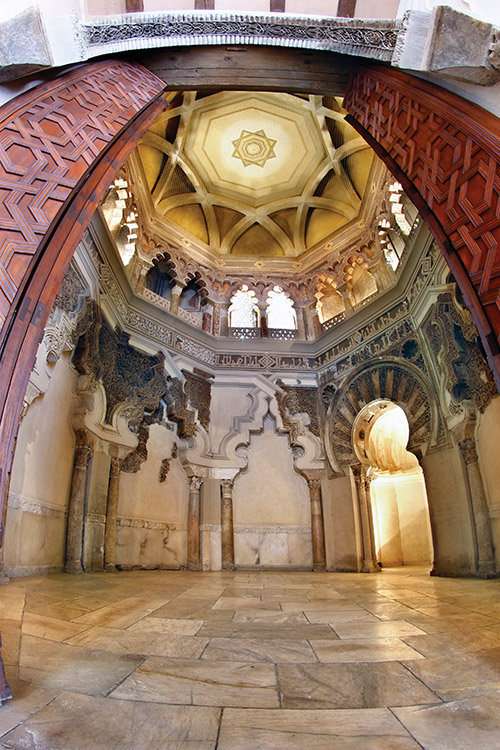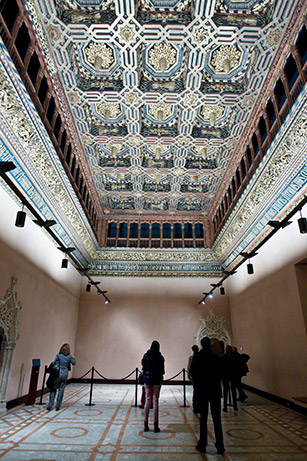Aljafería Palace
Inside this impressive fortress of thick walls and solid towers lies a fantastic treasure: three separate palaces.

The Taifal Palace of Al-Muqtadir:
Originally, on this site, there was already a defensive tower called Torre del Trovador, built in the 9 th century with a quadrangular design on three levels. Two centuries later Al-Muqtadir built a palace as a residence for the Hudid rulers of Saraqusta (Zaragoza) and incorporated this tower into the palace walls.
With this palace, he wanted to represent all the splendour and achievements of this Taifa kingdom at its political and cultural peak.
Here in lies the huge importance of the palace: it’s the only remaining example of a large building of Hispanic Islamic architecture from the Taifa period.
The riches of the palace are mainly concentrated in three places:
- Golden Hall: tNo sooner after you pass through the entrance, you’ll be struck by the subtle geometric patterns, slim multifoil arches with alabaster pillars and wooden panelled ceiling decorated with the stars of the cosmos. The entire combination creates a sense of both dignity and beauty.
- The mosque and the chapel: At the eastern end of the entrance hall is a small private mosque or chapel for use by the monarch and his courtiers.The front of the mirhab is made up of a traditional horseshoe arch and ring of stones, alternating between smooth stones and plant-based reliefs.
- The patio of Santa Isabel: This is an open, gardened courtyard that unifies the entire palace. Here, surrounded by multifoil arches, water falls into a pool, symbolising the importance of water in Muslim culture..

Palace of Pedro IV
After the conquest of Zaragoza in the year 1118 by Alfonso the Battler, this became the residence of the Christian Monarchs of Aragón. It wouldn’t be until the 14 th century that Pedro IV would expand the palace buildings and build the church of San Martín within the enclosure. The alterations carried out in the palace turned it into the main starting point of the Aragonese Mudéjar style. The traces of crossed mixtilinear arches are a prominent feature of this palace that would go on to influence future Islamic buildings. In 2001, the Mudéjar remains of this palace were included as part of the Mudéjar Architecture of Aragón, a UNESCO World Heritage Site.
The traces of intertwined mixtilinear arches are characteristic of this palace and from here they will spread to the future Islamic buildings.
The Mudejar remains of this palace will be declared a World Heritage Site by UNESCO in 2001.
Palace of the Catholic Monarchs:
At the end of the 15 th century, the Catholic Monarchs ordered the construction of a new level to the existing buildings with a gracious staircase linked the two floors. The ceilings are decorated with motifs related to the Catholic Monarchs, such as arrows, shields and pomegranates.
Since 1987, The Aljaferia has been the home of the Aragonese Corts, the regional parliament.

